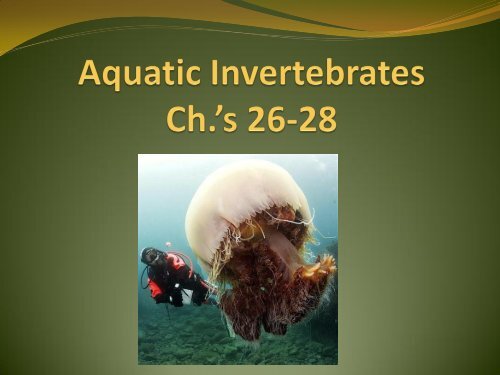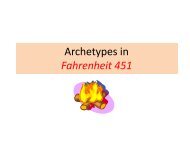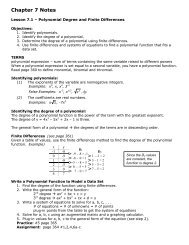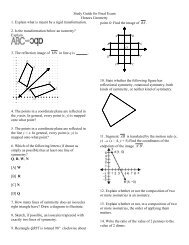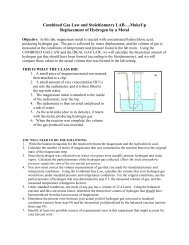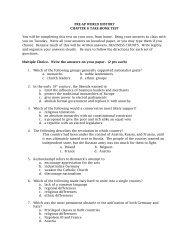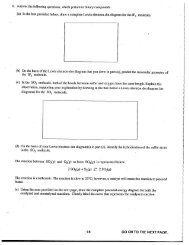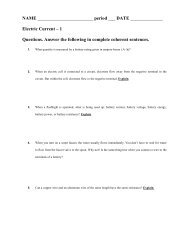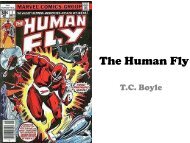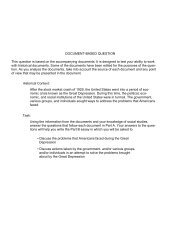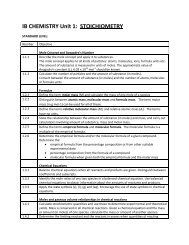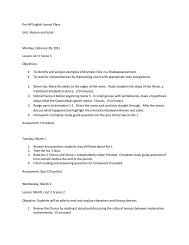Ch. 26-28 Aquatic Invertebrates
Ch. 26-28 Aquatic Invertebrates
Ch. 26-28 Aquatic Invertebrates
You also want an ePaper? Increase the reach of your titles
YUMPU automatically turns print PDFs into web optimized ePapers that Google loves.
Learning objective:<br />
• For each of the phylums and classes we look at today,<br />
we will identify:<br />
• Method of fertilization and reproduction<br />
• Type of body cavity<br />
• Skeletal structure<br />
• Body symmetry<br />
• Body coverings<br />
• Locomotion<br />
• Special features
I. <strong>Aquatic</strong> invertebrates<br />
A. Phylum PORIFERA<br />
• Porifera – literally means<br />
“pore-bearers” – sponges have<br />
tiny pores, or openings, all over<br />
their body.<br />
• Ex. Sponges<br />
• All aquatic (water-dwelling) –<br />
most are marine (salt-water)
REPRODUCTION:<br />
• Asexual – budding or gemmules (can survive harsh<br />
conditions)<br />
• Sexual – sperm fertilizes egg INSIDE body wall of sponge =<br />
INTERNAL FERTILIZATION.<br />
Giant barrel sponge spawning
STRUCTURE:<br />
• Water enters through pores, and<br />
leaves through large hole in the<br />
top, the OSCULUM.<br />
• Cells called choanocytes line the<br />
inside of the sponge. They use<br />
their flagella to sweep water in<br />
through the pores.<br />
• Sponges are FILTER FEEDERS –<br />
they filter out materials from the<br />
water as it passes through.
STRUCTURE:<br />
• Sponges have spike-shaped<br />
structures called spicules.<br />
Purpose: to deter predators<br />
from eating sponge.<br />
• Softer sponges have a<br />
“skeleton” of spongin –<br />
network of protein fibers.<br />
• These are the sponges used<br />
for natural bath sponges.
Porifera –the sponges<br />
• Sponges are<br />
asymmetrical – no<br />
symmetry<br />
• Sessile (non-moving)<br />
adults; free-swimming<br />
larva<br />
• Simplest animals – no<br />
tissues<br />
• Probably the most ancient<br />
animals – may have been<br />
the first “animals” to<br />
appear on Earth.
Ping-pong tree sponge
B. Phylum Cnidaria<br />
• Examples: jellyfish, sea anemones, corals, hydra
Name origin:<br />
• Cnidarians get their names from cnidocytes, or stinging<br />
cells, that are located along their tentacles.<br />
• Within each cnidocyte is a nematocyst – a stinging structure<br />
that contains a tightly coiled dart.<br />
• The nematocyst is released when something touches it, and<br />
will shoot the barbed dart into the prey.<br />
• The barb contains a poison that will kill or paralyze small<br />
prey.
<strong>Ch</strong>aracteristics of the phylum cnidaria:<br />
• All aquatic, mostly marine.<br />
• Radial Symmetry<br />
• Evolutionarily, cnidarians represent the first animals to<br />
develop tissues, and an opening for eating and excreting<br />
waste.<br />
• Single body opening through which food enters and waste<br />
leaves.
Reproduction in Cnidarians:<br />
• Sexual Reproduction<br />
• Corals “spawn” by releasing sperm and egg into the<br />
water where EXTERNAL FERTILIZATION occurs.<br />
• Asexual Reproduction<br />
• Some cnidarians can also reproduce asexually through<br />
budding.
Cnidarian Life cycle:<br />
• Jellyfish are motile (medusa) as adults, but sessile<br />
(polyps) as juveniles.<br />
• Some hydra – sessile (polyps) as adults, motile<br />
(medusa) as juveniles.
C. Phylum Mollusca<br />
• Name origin: Latin word “molluscus”, meaning soft<br />
• Mollusks are soft-bodied animals that usually have an internal or<br />
external shell.<br />
• They are coelomates–they have a true body cavity (coelom)<br />
• Bilateral symmetry<br />
• A few mollusks are hermaphrodites – they have both male and<br />
female gonads. Usually, they do not fertilize themselves.<br />
• Gastropods, cephalopods, and bivalves all belong to the phylum<br />
mollusca.
• Some mollusks have external shells made of calcium<br />
carbonate. These shells are secreted by a portion of<br />
their body, and are attached.
1. Class Cephalopoda<br />
• Name means: “head-footed”<br />
• Examples: cuttlefish, squid,<br />
octopuses, nautilus<br />
• Reproduction: Sexual, with<br />
internal fertilization<br />
• Protective structure: small<br />
internal shell or no shell at<br />
all. (except nautilus –<br />
external shell)
Cephalopod characteristics:<br />
• Special body structures: tentacles with sucking<br />
discs for catching prey.<br />
• Locomotion: VERY motile – they use jet propulsion<br />
to move around<br />
• Well-developed nervous system and sensory organs<br />
(eyes). Very intelligent.<br />
• Can excrete ink to get away from predators.
2. Class Gastropoda<br />
• Name means: “stomachfooted”<br />
• Ex. Snails, slugs<br />
• Many are NOT aquatic,<br />
and dwell on land<br />
• Reproduction: Sexually,<br />
external fertilization<br />
• Some snails may have<br />
internal fertilization
Gastropods:<br />
• Have one or no shell<br />
• Motile; some secrete<br />
slime, and then glide<br />
upon their slime trail<br />
• Feed by scraping food off<br />
of surfaces with a rough<br />
tongue called a radula
3. Class Bivalvia<br />
• Name means: “2 valves/shells”<br />
• Ex: clams, oysters, scallops,<br />
mussels<br />
• Reproduction: sexual – external<br />
fertilization<br />
• They have 2 shells that are held<br />
together by one or two powerful<br />
muscles
Bivalves:<br />
• Most bivalves stay in one place<br />
for most of the time.<br />
• Scallops can move very quickly<br />
to escape by clapping their<br />
shells together.<br />
• Bivalves are filter feeders -<br />
they filter out particles in the<br />
water, and can take in<br />
pollutants and viruses. You<br />
can get sick from eating raw<br />
oyters.
D. Phylum Echinodermata<br />
• Name means: “spiny skin”<br />
• Ex. Sea stars, sand dollars,<br />
sea urchins, sea cucumbers<br />
• Echinoderms are the only<br />
phylum that is entirely<br />
marine.<br />
• Reproduction: Sexual<br />
(external fertilization)<br />
• Capable of regeneration
Echinoderms:<br />
Sea cucumber<br />
Sea cucumber
<strong>Ch</strong>aracteristics of echinoderms:<br />
• 5 part radial symmetry<br />
• Internal skeleton<br />
• Water vascular system – pumps water through body to move<br />
tube feet. It also functions in respiration and circulation.<br />
• Tube feet – little tube-like extensions on bottom of arms, used<br />
to move and grasp prey.
Ecological importance of echinoderms:<br />
• A “keystone” in an archway is a wedge-shaped piece of stone in<br />
the center of the arch. If you remove the keystone, the arch will<br />
collapse.<br />
• Echinoderms are often keystone species – removal of them<br />
from the ecosystem will cause that ecosystem to collapse.<br />
• Keystone predator– helps keep competition between prey species<br />
even, so that one prey species doesn’t outcompete the others.<br />
• On the West Coast of North America, for instance, removal of a<br />
certain species of starfish caused a rapid growth in the numbers of<br />
mussel upon which the starfish fed. This can throw off the balance<br />
of an ENTIRE ECOSYSTEM>


